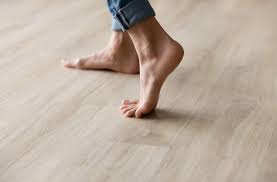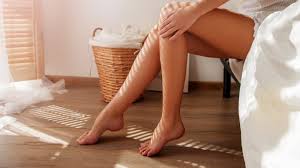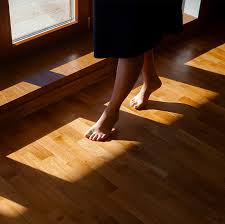Are bare feet bad for hardwood floors?
Most parents and professional cleaners have a legitimate reason for wanting to keep outdoor shoes, well, outdoors, and that has to do with keeping the soles of our shoes from tracking dirt, grime, toxins like pesticides and industrial pollution, and traces of both human and animal waste into our homes. Outdoor shoes are even known to offer free passes to bacteria that can cause health issues, although that risk could be slightly exaggerated, according to The New York Times.
Many cultures practice shoe-free homes across Asia and the Middle East. But is the option of going barefoot — or perhaps just wearing soft fluffy slippers — at home a habit we should all be adopting? According to some podiatrists, the answer is a resounding, “no.” And it’s not because they aren’t concerned about having us invite a few germs and some grime into the house. Rather, they worry that going barefoot around the house could open up our feet to developing different types of structural injuries.

Hardwood Floors May Be Killing Your Feet
“My feet are killing me” is a common phrase we hear from patients suffering from foot and heel pain. Your hardwood floors may not actually be killing you, but they are likely irritating your feet. The days of green shag carpet—which offered shock absorption and comfort for our feet—have been replaced by stiff surfaces like hardwoods, laminates, and tile that cause more wear and tear on our feet. So if you find yourself missing the days of green shag carpet, you are not alone. Your feet miss it too!
Where do you find long stretches of concrete sidewalks, tile floors, or hardwood floors occurring naturally? The answer is nowhere. Humans have been wearing variations of shoes for thousands of years, but the increase in foot and heel pain may be related to more recent decorative changes.
As we’ve moved from shag carpets to laminates, hardwood, and tile floors, our feet have paid the price. More and more people have begun suffering from plantar fasciitis. Plantar fasciitis is an inflammation of the tissues at the bottom of the foot and a leading cause of foot pain. This can lead to pain in the arches or heels of the foot, which worsens when the foot pronates or flattens on hard surfaces. The pain can be severe and debilitating.

Noninvasive treatments to consider:
Did you know that chiropractors can do adjustments on feet? There are 26 bones in the foot, and just like the spine, the mobility of these joints can become restricted. When it comes to the cause of plantar fasciitis, studies have shown that “Reduced ankle dorsiflexion appears to be the most important risk factor.” This means that reduced ankle movement is an underlying cause of the pain. Improved joint mobility can minimize pain and eliminate dysfunction.
Patients have had great success with therapeutic foot taping, custom orthotics, and of course, chiropractic adjustments. Over-the-counter insoles can be beneficial, however, custom orthotics do tailor to each foot’s unique arch.
The good news though is that nonsurgical management of plantar fasciitis is successful in about 90 percent of patients. So there is hope—even if you dearly love your hardwood floors!”
As with most conditions, conservative treatment works best at the start of foot and heel pain. See a professional sooner rather than later if you are struggling with foot and heel pain.

Wearing shoes will protect your feet against bacteria and fungi
If you’re a germaphobe, this may put you off going around your house in bare feet for life: Your floors may be clean, but they can’t really ever be completely germ free, and walking barefoot indoors exposes your feet to potential infections caused by bacteria and fungi. These organisms first infect the skin, and then they may infect the nails, leading to thickening, discoloration and brittleness of the nails. Both conditions become not only unsightly but also contribute to an unpleasant odor.
The best way to protect your feet is to pick up a good pair of indoor shoes, which you can change into when you get home. Doctors recommend looking for a pair that provides good arch support, particularly if you already suffer from a foot condition, such as weak arches or bunions.
Wood Flooring: 5 Costly Mistakes You Can Avoid
Wood flooring is one of the top choices, as it has been throughout the years. It adds elegance and warmth to a room, and it is versatile in that homeowners can add stains for changes in color or top with an accent rug for a softer feel. Many homes that have original wood flooring can use this as a selling point, and buyers pay top dollar for wood floors that are in good condition
1. Not engaging in preventative measures
Before anyone walks across the new wood floor, make sure to take some preventative measures. Place doormats at all doorways so that family members and guests can wipe their shoes before walking into your home. Cover the legs of all pieces of furniture with felt so that they can easily slide in and out without the metal feet scratching the floors. Think about strategic placement of runners and area rugs in high traffic areas. These are only some of the ways that you can be your wood floor’s best ally.
2. Using abrasive cleaning products
When it comes to wood floors, there are certain cleaning products and chemicals that should never touch the surface. If your floor has a coat of sealant or lacquer, you should use different cleaning products than if it is unfinished.
All wood floors can be swept with a broom or dry mop, but avoid using chemicals that can deteriorate the finish or warp the wood. If you use liquid floor cleaner, apply it to the mop or cloth instead of pouring it directly onto the floor. When shopping for flooring cleaning products, tell your vendor exactly what kind of wood floor you’ve got. And then proceed accordingly.
3. Forgetting about your pets and their habits
Animals can cause a lot of damage to wood floors, whether from an accident that is left untreated or from long nails that can cause scratches and dings. Clean up any spills or accidents as soon as they happen to prevent warping, and keep their nails trimmed. See your vet on how to do this properly. Additionally, if food or water bowls sit on the floor, keep silicone mats beneath them so that spills don’t seep into the floor.
4. Wearing shoes indoors
High heeled shoes can ding and dent a wood floor, so ask guests to remove their shoes, and always remove yours when you come into your home. These shoes are more damaging when they don’t have rubber heel protectors since they can basically become chisels that make holes in the wood.
Dirty or wet shoes can also cause the floors to warp and shift, so the best option is to simply walk barefoot or in socks when walking on the hardwood. Or, if you really want to keep your feet warm, wear comfy indoor slippers. Be comfortable, and protect your wood floors at the same time.
5. Using aggressive cleaning tools
Steam mops might seem like a good way to remove bacteria from wood floors, but they can result in serious damage. Use minimal amounts of cleaning products on your floors, and always use soft towels to wipe up the floors. An antibacterial floor cleaner is a better way to eliminate germs and bacteria on the floors.